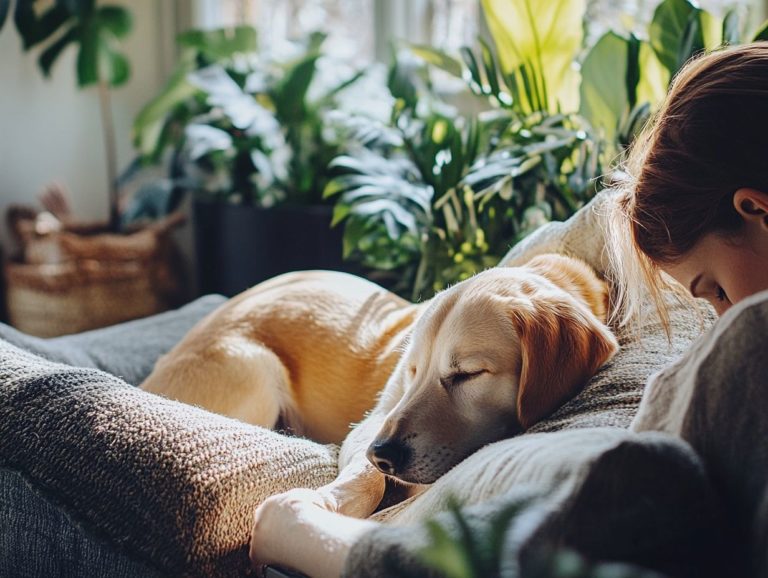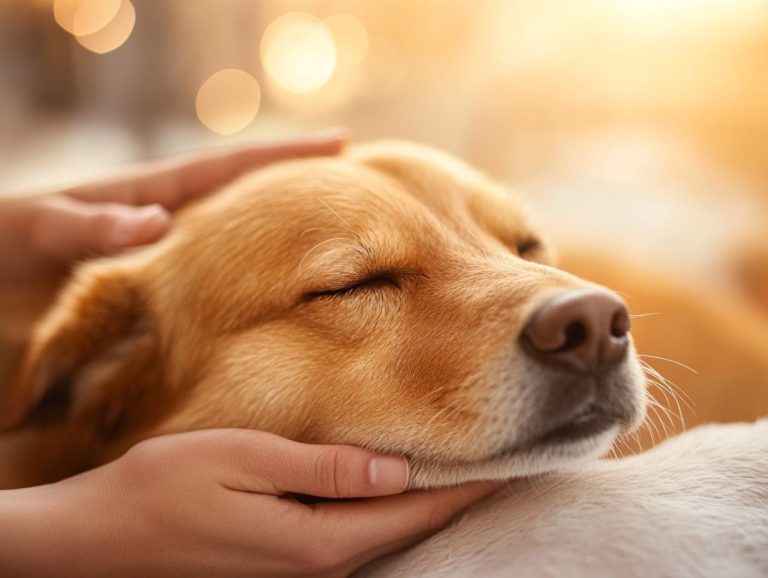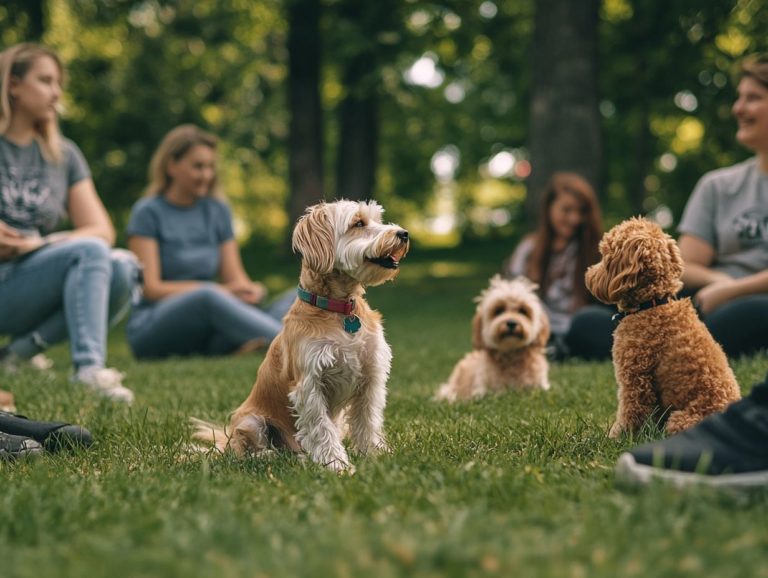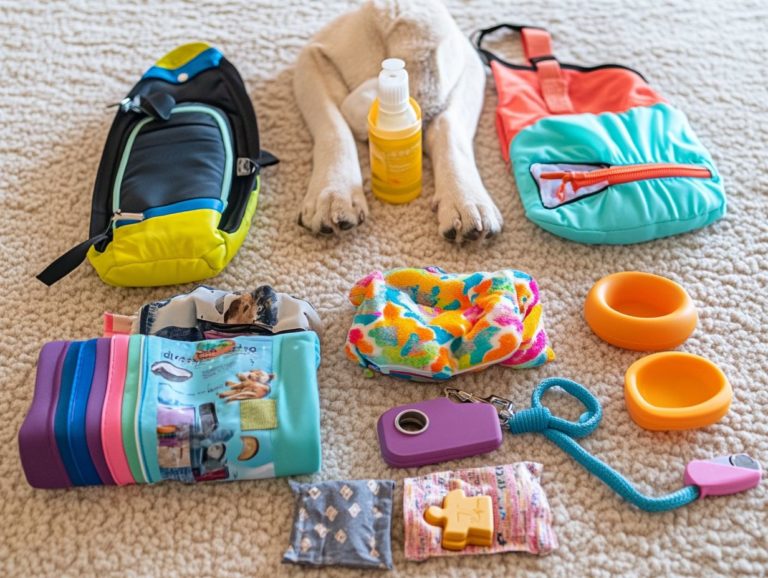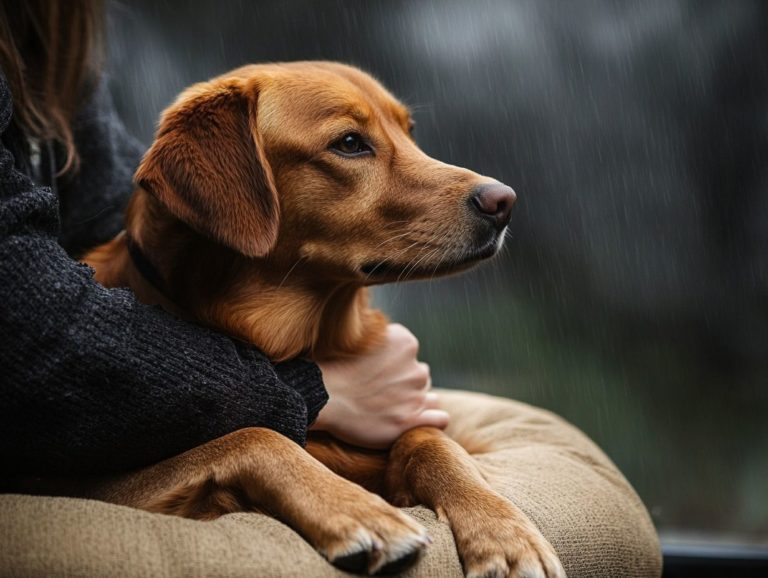The Importance of Patience in Training Anxious Pets
Anxiety isn’t solely confined to human experiences; your pets can feel it too, significantly affecting how they act and their overall well-being.
Recognizing how anxiety reveals itself in pets is essential for you to provide the appropriate support they need.
This article delves into the importance of patience in training anxious animals, offering insightful tips and effective techniques to cultivate a calming environment.
By nurturing a supportive space and utilizing calming tools, you can guide your furry companions through their fears, helping them to thrive.
Read on to learn how you can truly transform your pet s life!
Contents
- Key Takeaways:
- How Anxiety Affects Your Pet
- Why Patience is Key in Training Anxious Pets
- Practical Tips for Practicing Patience
- Creating a Supportive Environment for Anxious Pets
- Frequently Asked Questions
- What is the importance of patience in training anxious pets?
- How can patience benefit both the pet and the owner during training?
- What are some examples of patience techniques in training anxious pets?
- Why is it important to understand the root cause of your pet’s anxiety?
- Can a lack of patience in dog training lead to negative behaviors in anxious pets?
- How can one practice patience when training an anxious pet, especially in the context of managing reactive dog behavior?
Key Takeaways:

- Patience is crucial in training anxious pets as it helps create a calm and supportive environment for them.
- By understanding the impact of anxiety on pets and using a calming approach, pet owners can effectively train and improve their pet’s behavior and well-being.
- Practical tips such as using effective training techniques and creating a safe and comfortable space can greatly aid in training anxious pets with patience and compassion.
How Anxiety Affects Your Pet
Anxiety in pets can greatly affect how they act and their overall well-being, often resulting in issues like separation anxiety and reactive dog behavior. This emotional turmoil may manifest as attention-seeking behavior, aggression, or withdrawal, complicating the bond between you and your beloved canine companion.
It s crucial to grasp how anxiety affects canine behavior, as this understanding lays the groundwork for developing effective training techniques and rehabilitation methods that improve both mental health and social interactions.
The growing number of support groups and resources can help you tackle these common challenges with confidence and efficiency.
Understanding the Effects on Behavior and Well-being
Understanding the effects of anxiety on your canine companion’s behavior is essential for ensuring their well-being, as anxiety can lead to a range of behavioral problems in dogs.
You might notice these issues manifesting in various ways. For example, heightened attention-seeking behavior could lead your pet to cling to you, following you around obsessively, or even displaying signs of aggression when they feel threatened.
Such behavioral changes not only strain the bond between you and your furry friend but also create an atmosphere filled with tension and fear. That s why it s crucial to recognize these signs to address the root causes of their anxiety.
Employing effective dog training techniques, including rewarding good behavior and clicker training, and maintaining clear communication can significantly alleviate these issues. By doing so, you ll help your pet feel secure and understood, ultimately enhancing their quality of life.
Why Patience is Key in Training Anxious Pets
Patience is absolutely essential in dog training, especially when you’re working with anxious pets. A calm and understanding approach is key to building trust and creating positive learning experiences.
Techniques that emphasize patience in dog training and positive reinforcement can dramatically minimize stress and anxiety, allowing your canine companion to thrive in a nurturing environment. This holds particularly true for breeds like the Jack Russell Terrier, which can exhibit increased anxiety if not handled with the utmost care.
Trainers who prioritize patience are invaluable, guiding you through the rehabilitation process and paving the way for successful training outcomes.
Recognizing the Need for a Calming Approach
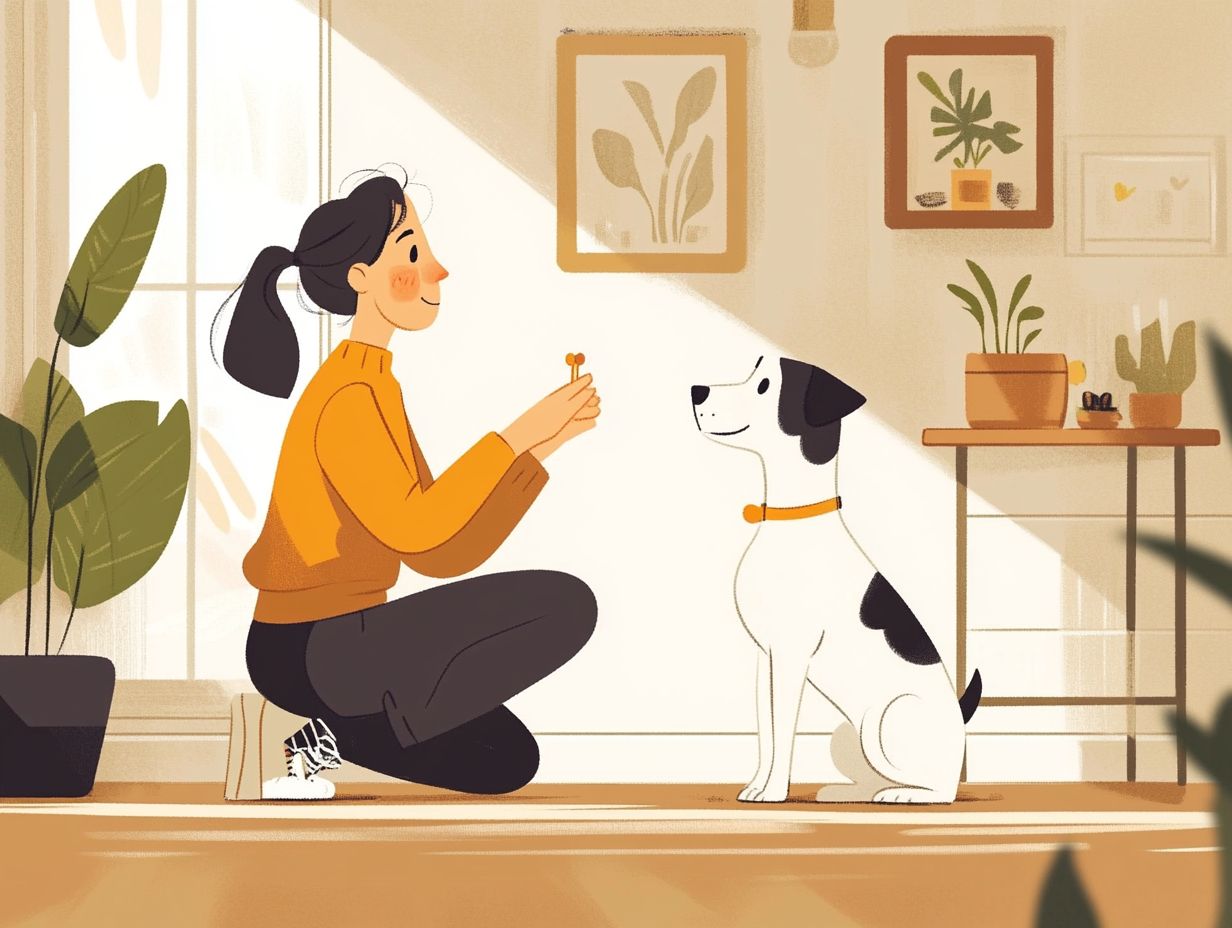
Recognizing the importance of a calming approach in dog training is crucial, especially when dealing with pets that experience separation anxiety and related issues. Implementing training techniques to manage aggression in anxious pets can make a significant difference.
Use techniques like deep breathing exercises and a soft tone to help diffuse tension. Creating a serene environment can greatly help the training process, including understanding leash training for anxious dogs, allowing them to feel secure and open to learning.
Incorporating calming aids such as anxiety wraps or pheromone diffusers can further enhance your pet’s sense of safety. Regularly introducing gentle play sessions and gradually exposing them to new experiences or environments will also build their confidence.
Fostering a nurturing atmosphere can make a big difference. It helps your pet manage stress and leads to better training results!
Practical Tips for Practicing Patience
Practicing patience in dog training is essential. It demands practical tips and techniques that will enable you and your dog to navigate the intricacies of anxious behavior with greater ease, including understanding the importance of routine for anxious pets.
Effective Training Techniques
Use effective training techniques like positive reinforcement and clicker training. These invaluable tools help you as a dog trainer working with anxious pets.
These methods not only modify dog behavior problems but also lay a strong foundation of trust between you and the dog. By employing positive reinforcement, you reward desirable behaviors with treats or praise, creating a supportive environment that encourages learning.
For example, using small, high-value treats during training can significantly motivate a nervous dog, making the process both enjoyable and effective. Clicker training is especially beneficial for anxious dogs, as it offers clear communication.
The distinct sound of the clicker signals a job well done, helping the dog associate good behavior with positive outcomes. Over time, this builds confidence, making the dog feel more secure and responsive, which can greatly reduce anxiety in various situations.
Creating a Supportive Environment for Anxious Pets
Creating a supportive environment for anxious pets is essential for their rehabilitation and overall well-being. Joining support groups or attending dog training courses can further enhance this nurturing atmosphere.
This environment fosters a sense of safety and security and plays a pivotal role in alleviating their stress.
Creating a Safe and Comfortable Space
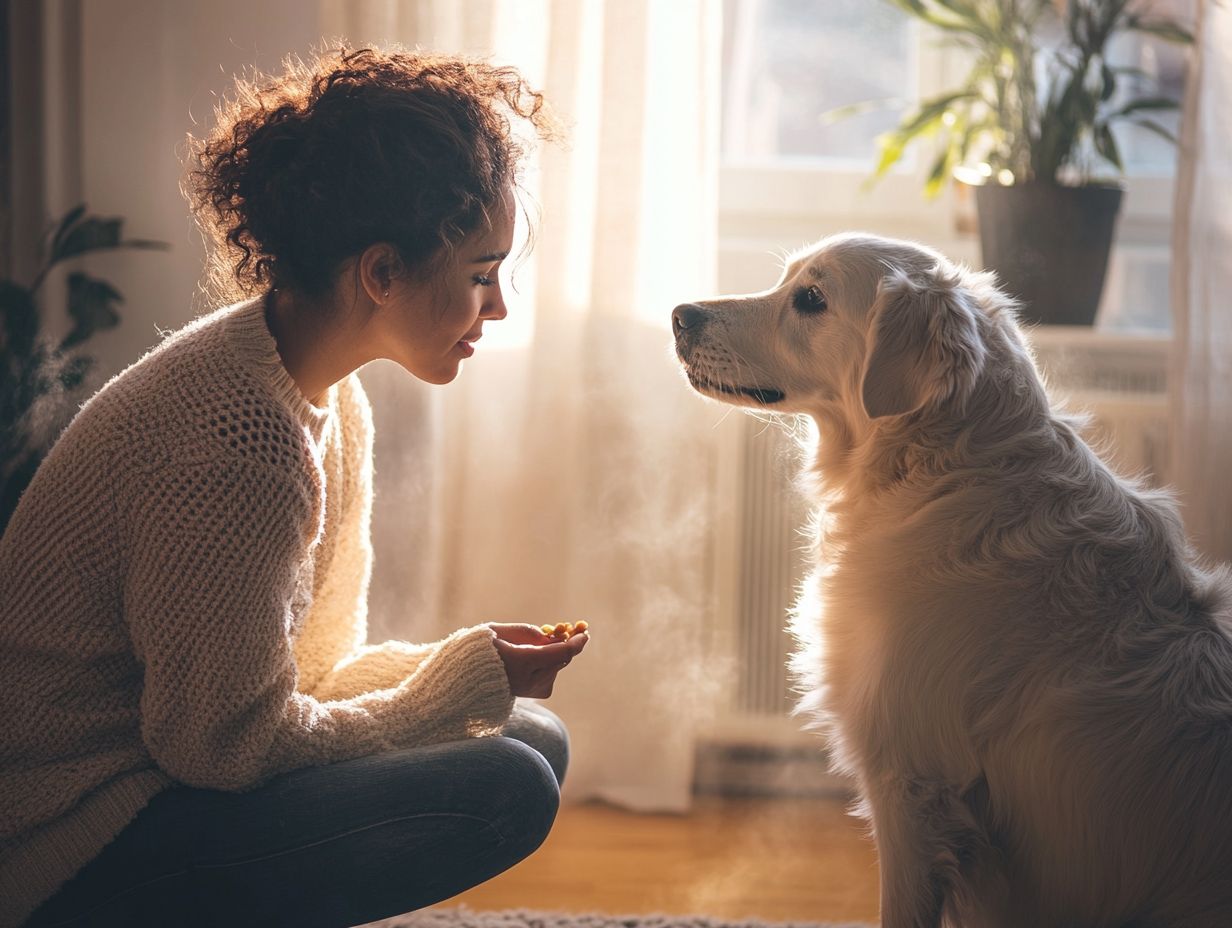
Creating a safe and comfortable space for your anxious pet is a crucial step in tackling common dog behavior issues, like separation anxiety.
This space should be uniquely tailored to your dog s needs, featuring calming elements such as a cozy bed, familiar toys, and maybe even a piece of your clothing for added comfort to foster canine learning.
Enhancing the atmosphere with calming tools like pheromone diffusers or sound machines designed specifically for dogs can work wonders in reducing stress levels.
Incorporating techniques like gradual desensitization and positive reinforcement training can further cultivate a sense of security for your furry friend, handling dogs that react strongly to situations.
When you thoughtfully craft these environments, they not only promote relaxation but also play a significant role in your pet’s overall mental well-being. This leads to more positive interactions and a reduction in anxiety-related behaviors.
Utilizing Calming Tools and Techniques
Using calming tools and techniques can improve your dog training.
This fosters relaxation and helps alleviate anxiety in your furry friend.
These simple practices create a calming space, essential for your dog’s learning and for addressing dog behavior issues. For example, incorporating pressure wraps can provide gentle pressure, mimicking the comforting sensation of a hug and helping to soothe stressed canines.
Pheromone diffusers release soothing scents that ease anxiety in many dogs, making them more open and receptive during training sessions.
Playing calming music or engaging in gentle play can create a peaceful atmosphere, encouraging focus and comfort. Together, these strategies not only address reactive behavior but also enhance your dog’s overall well-being, ensuring they feel secure and enthusiastic about training.
Frequently Asked Questions
What is the importance of patience in training anxious pets?
Patience is crucial in training anxious pets because they require time and understanding to overcome their fears and anxieties. The role of trust in training anxious pets is vital; rushing the training process can lead to setbacks and increase anxiety.
How can patience benefit both the pet and the owner during training?
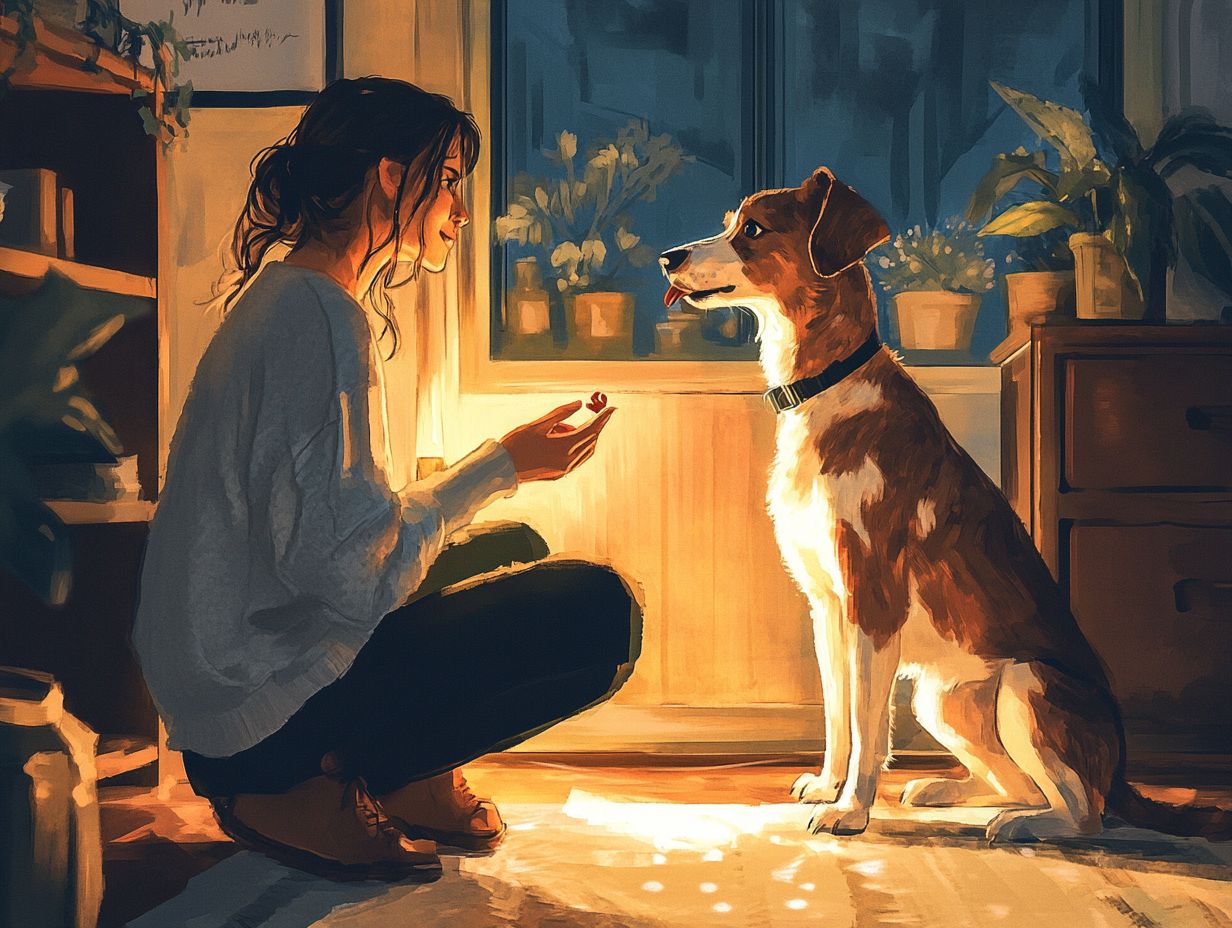
Patience allows the pet to progress at their own pace, reducing their stress and building trust with their owner. Understanding the needs of anxious pets also helps prevent the owner from becoming frustrated and giving up on the training, leading to a stronger bond between them and their pet.
What are some examples of patience techniques in training anxious pets?
Examples of patience in training anxious pets include giving them time to adjust to new environments, using positive reinforcement techniques, and establishing a routine to slowly introduce them to new experiences or triggers.
Why is it important to understand the root cause of your pet’s anxiety?
Understanding the root cause of your pet’s anxiety is essential because it allows you to tailor their training to address the specific triggers or fears causing their anxiety. This can lead to more effective and long-lasting results.
Can a lack of patience in dog training lead to negative behaviors in anxious pets?
Yes, a lack of patience in training can cause anxious pets to develop negative behaviors such as aggression, destructive chewing, and excessive barking. This occurs because they are not given the time and understanding they need to overcome their fears, which is why understanding positive reinforcement for anxious pets is crucial.
How can one practice patience when training an anxious pet, especially in the context of managing reactive dog behavior?
One can practice patience when training an anxious pet by being consistent, using positive reinforcement, and taking breaks when needed. Understanding the importance of socialization for anxious pets is also crucial, along with having realistic expectations and celebrating small victories along the way.
Start using these calming tools today and see the difference in your dog’s training journey!

